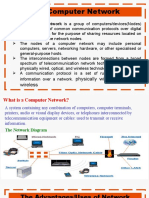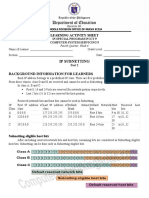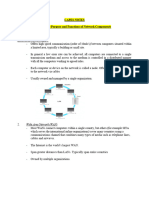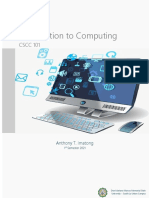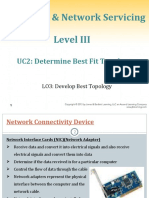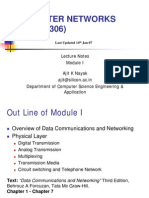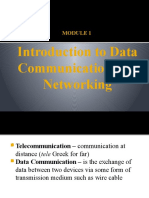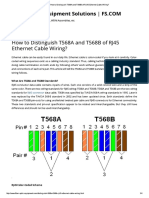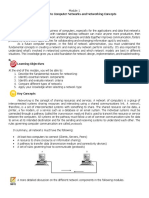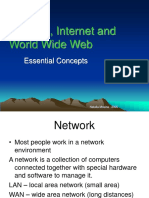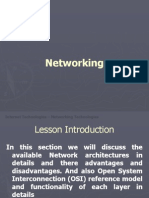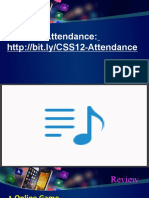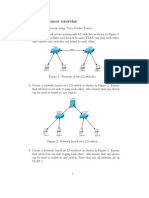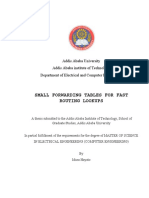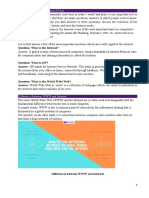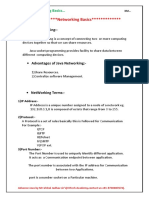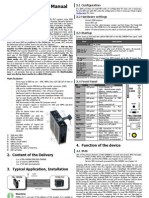Networking Principles & Topologies
Uploaded by
Achin BatwaraNetworking Principles & Topologies
Uploaded by
Achin BatwaraIntroduction to Computer Networks
CSE1004 – Network and
Communication
Dr. H. Santhi, Associate Professor, SCOPE
Module-1: Networking Principles
2
and Layered Architecture
Data Communication Model
Data Flow
Line Configuration or Types of Connection
Networks - Need of Network – Applications - Categories of Networks
Network Topology
Protocols and Standards
Network Models(OSI, TCP/IP)
Dr. H. Santhi, Associate Professor, SCOPE
Data communication Model
3
Message : Is the information to be
communicated. Popular forms of
information include text, numbers, pictures,
audio and video.
Sender: Is the device that sends a message.
It can be computer, workstation, telephone,
video camera and so on.
Receiver: Is the device that receives the
message. It can be computer, workstation,
telephone, video camera and so on.
Protocol: Is a set of rules that both sender
and receiver must agree.
Transmission Medium : Is the physical
path by which a message travels from
sender to receiver.
Example : Twisted-pair cable, Coaxial cable,
Fibre-optic, and radio waves
Dr. H. Santhi, Associate Professor, SCOPE
Characteristics
4
The effectiveness of data communication system depends on:
Delivery: The system must deliver the data to the correct destination.
Accuracy: The system must deliver the data accurately.
Timeliness: The system must deliver data in a timely manner.
Jitter: The variation in the packet arrival time.
Some packets arrives at 30 ms and some at 40 ms, leads to uneven quality.
Dr. H. Santhi, Associate Professor, SCOPE
Network Criteria
5
The important network criteria are:
1. Performance: Depends on number of factors, including number of
users, type of transmission medium used, capabilities of
hardware, and the efficiency of the software.
It can be measured in many ways:
Transit time(ms) – The amount of time required for a message
to travel from one device to another.
Response time(ms) – Is the elapsed time between a request
and a response.
Throughput(bps) – Number of packets transmitted per
second.
Delay(ms)
Dr. H. Santhi, Associate Professor, SCOPE
Network Criteria
6
2. Reliability - Network reliability is measured by
the frequency of failure,
the time it takes a link to recover from failure, and
the network robustness in a catastrophe.
3. Security – Protecting data from unauthorized access by means
of implementing procedures and policies to recover from
breaches and data losses.
Dr. H. Santhi, Associate Professor, SCOPE
Data Flow/ Transmission Mode
7
Dr. H. Santhi, Associate Professor, SCOPE
Simplex
8
In simplex mode, the
communication is
unidirectional.
Only one of the two devices
on a link can transmit; the
other only can receive.
The simplex mode can use the
entire capacity of the channel
to send data in one direction.
Example: Keyboard and
Monitors
Dr. H. Santhi, Associate Professor, SCOPE
Half-Duplex
9
In half-duplex mode, each
station can transmit and
receive, but not at the same
time.
When one device is sending,
the other can only receive,
and vice versa.
Entire capacity of the channel
can be utilized for each
direction.
Ex: Walkie-talkies
Dr. H. Santhi, Associate Professor, SCOPE
Full-Duplex/Duplex
10
In full-duplex mode, both
stations can transmit and
receive simultaneously.
The capacity of the channel is
divided in both directions.
Example: Telephone network.
Dr. H. Santhi, Associate Professor, SCOPE
Type of Connection
11
In a network devices are connected through links.
Link - Is a communication pathway that transfers
data from one device to another.
Dr. H. Santhi, Associate Professor, SCOPE
Point-to-Point
12
A point-to-point connection
provides a dedicated link
between two devices.
The entire capacity of the link
is reserved by those two
devices.
Ex: TV Infrared Remote
Control
Dr. H. Santhi, Associate Professor, SCOPE
Multipoint/Multidrop
13
Also called mutlidrop
connection.
Two or more devices share a
single link.
The capacity of the channel is
shared.
Dr. H. Santhi, Associate Professor, SCOPE
Network topology
14
A topology is a geometrical representation of relationships
between all the links and devices(nodes) in a network.
Topologies can be either physical or logical.
Physical topologies describe how the cables are run.
Logical topologies describe how the network messages travel.
The basic four topologies are:
Mesh
Star
Bus
Ring
Others: Tree and Hybrid
Dr. H. Santhi, Associate Professor, SCOPE
Mesh Topology
15
Dedicated Point-to-point link.
Link carries traffic only between the two devices it connects.
For “n” nodes in a fully connected mesh topology with duplex mode, the number
of links required = n(n-1)/2.
No of I/O ports needed = n-.
If n=5, then links needed=10.
I/O ports = 4.
Advantages:
1) Eliminates traffic problem.
2) Robust.
3) Easy fault detection and isolation.
4) Privacy/Security - Prevents other user from gaining access to messages.
Disadvantages:
1) Number of cabling and I/O ports is high.
2) Reconfiguration is difficult.
Dr. H. Santhi, Associate Professor, SCOPE
Star Topology
16
Dedicated point-to-point link to the central controller called hub.
Devices are not linked to one another.
Unlike mesh, star does not allow direct communication between devices.
Controller acts as an exchange.
Advantages:
1) Less expensive than mesh in terms of cabling and I/O ports.
2) Installation and reconfiguration is easy.
3) Robust.
4) Easy fault deduction and isolation.
Disadvantages:
1) Dependency on hub.
2) Hub goes down then entire network is dead.
Dr. H. Santhi, Associate Professor, SCOPE
Bus Topology
17
Oldest topology.
Provides multipoint connection.
Uses long cable as a backbone.
Devices are connected by using drop line and tap.
Advantages:
1) Easy installation.
2) Less number of cables than mesh and star.
Disadvantages:
1) Fault detection and isolation is difficult.
2) Reconfiguration is not possible - adding new devices are not possible. This limits
the number of devices.
3) Adding new devices needs a replacement of main cable.
4) Bus goes down then the entire network is dead.
Dr. H. Santhi, Associate Professor, SCOPE
Ring Topology
18
Developed by IBM.
Provides point-to-point connection.
Each node is linked with the nodes on either side of it.
Uses token passing mechanism.
Each device incorporates “repeater” – Regenerates the bits and passes
them along the ring.
Advantages:
1) Easy to install and configure.
2) Easy fault detection and isolation.
Disadvantages:
1) Unidirectional traffic with single ring.
2) Fault in the ring disable the entire network.
Note: These problems can be eliminated by using dual ring.
Dr. H. Santhi, Associate Professor, SCOPE
Tree Topology
19 Dr. H. Santhi, Associate Professor, SCOPE
Hybrid Topology
20 Dr. H. Santhi, Associate Professor, SCOPE
Comparison
21
Dr. H. Santhi, Associate Professor, SCOPE
22
Dr. H. Santhi, Associate Professor, SCOPE
Considerations for choosing topology
23
Money-Bus n/w may be the least expensive way to
install a n/w.
Length-of cable needed- the linear bus n/w uses
shorter lengths of cable.
Future growth-with star topology, expending a n/w is
easily done by adding another devices.
Cable type-most common used cable in commercial
organization is twisted pair. Which often
used with star topologies.
Dr. H. Santhi, Associate Professor, SCOPE
Best Topology
24
Full mesh topology is theoretically the best since
every device is connected to every other device.(thus
maximizing speed and security. however, it quite
expensive to install)
Next best would be tree topology, which is basically
a connection of star.
Dr. H. Santhi, Associate Professor, SCOPE
Case Study Problem
A small, independent, business/home/life insurance company consisting of an owner, a business
25 manager, an administrator, and four agents decides to implement a network. The company
occupies half of a small building in an office park. Their volume of business had been stable for
the past three years, but recently it has been increasing. To handle the increased business
volume, two new agents will be hired.
Which network topology would be most appropriate in this situation?
Bus
Ring
Star
Mesh
Star bus
Star ring
Dr. H. Santhi, Associate Professor, SCOPE
Answer
26
There is no single correct answer. The most commonly installed networks currently
are the star bus and the bus. A hub-centered star bus seems to be the best choice
because of the ease of troubleshooting and reconfiguration. Although a bus network
might be chosen for its low cost or ease of installation, it does not offer the
centralized troubleshooting or administrative advantages of a hub. A ring is
probably more complex than is necessary for this network.
Dr. H. Santhi, Associate Professor, SCOPE
Problems
27
A small company with three departments recently began networking and has installed peer-to-
peer networks in each department. The peer-to-peer networks are not connected to each other.
A user in one department must make a diskette of the information to be loaded on the next
network. Four employees in one department are working on a project. Each person has a
different set of responsibilities, and each produces documentation for a different part of the
project. Employees have each made the hard drive on their own computers available to
everyone else on the project.
As the project grows, each user produces more documents, and questions arise about who has
which document and which employee last revised a given document. Also, employees outside
the department who have an interest in the project are asking to see some of the completed
material.
Why are problems arising concerning who has which document? Suggest at least one reason.
What one change could you make that would give you centralized control of the access to these
documents?
Describe one change that your solution will bring to the users' operating environment.
Dr. H. Santhi, Associate Professor, SCOPE
What is a Computer Network?
28
A computer network is a Characteristics of a computer
system in which multiple network:
computers are connected to Share Resources from one
computer to another.
each other to share
information and resources. Create files and store them in
one computer, access those files
from the other computer(s)
connected over the network.
Connect a printer, scanner, or a
fax machine to one computer
within the network and let other
computers of the network use the
machines available over network.
Dr. H. Santhi, Associate Professor, SCOPE
Hardware's required to setup a
29
computer network
Network Cables
Distributors
Routers
Internal Network Cards
External Network Cards
Dr. H. Santhi, Associate Professor, SCOPE
Computer Network
30
A network is a set of devices connected by
communications links.
Devices Used in Network:
Routers
Gateways
Repeaters
Bridges
Hub
Modem
Dr. H. Santhi, Associate Professor, SCOPE
Need/Use of Network
31
Resource Sharing
Hardware (computing resources, disks, printers)
Software (application software)
Information Sharing
Easy accessibility from anywhere (files, databases)
Search Capability (WWW)
Communication
Email
Message broadcast
Remote computing
Distributed processing
Dr. H. Santhi, Associate Professor, SCOPE
Introduction to Computer Networks
Network Applications
32
o E-mail
o Searchable Data (Web Sites) : Google, Bing, Yahoo, Baidu,etc
o E-Commerce : Amazon, ebay, flipcart,etc
o News Groups
o Internet Telephony (VoIP)
o Video Conferencing
o Chat Groups
o Instant Messengers
Dr. H. Santhi, Associate Professor, SCOPE
o Internet Radio
Categories of Networks
33
Classification of
network
Local Area Metropolitan Wide Area
Network Area Network Network
(LAN) (MAN) (WAN)
The main difference among these classifications is their area of
coverage.
Dr. H. Santhi, Associate Professor, SCOPE
Local Area Network(LAN)
34
A LAN is a private network that
connects computers and devices in a
limited geographically area such as
a home, school computer laboratory,
office building.
LAN’s are used to share resources
and to exchange information.
Traditional LAN’s run at 10-
100Mbps.
Common Topologies used are bus,
ring and star.
High data rates with less errors.
Dr. H. Santhi, Associate Professor, SCOPE
Types of LAN
35
PAN HAN
A Personal area network (PAN) is a
A House area network (HAN) is a
computer network used for
type of local area network that
communication among computer and
develops from the need to facilitate
different information technological
communication and interoperability
devices close to one person. Common
among digital devices present inside
Technologies used are USB, Bluetooth
or within the close vicinity of a home.
and Infrared. Range is ~10m
Smartphone Headphone
Laptop PDA
Mouse Printer
Dr. H. Santhi, Associate Professor, SCOPE
LAN
36
Advantages Disadvantages
• Easy to share devices • Power - a good LAN is
(printers, scanners, external required to be on all the
drives) times.
• Security - each computer and
• Easy to share data device become another point
(homework, pictures) of entry for undesirables.
• if all computers running at
• Cost of LAN Setup is low. once, can reduce speed for
each.
• Area covered is limited
Dr. H. Santhi, Associate Professor, SCOPE
Metropolitan Area Network(MAN)
37
Covers a larger geographical
area than is a LAN, ranging from
several blocks of buildings to
entire cities.
It may be a single network as a
cable TV network or it may be
means of connecting a number of
LANs into a larger network so
that resources may be shared.
MAN is wholly owned and
operated by a private company
or may be a service provided by
a public company.
Dr. H. Santhi, Associate Professor, SCOPE
MAN
38
Advantages Disadvantages
• Efficiency and shared • It can be costly
(hardware, software,
access. support, etc.)
• Security problems
• All the computer-
owning residents of • As the network consists
the area have equal of many computers over
ability to go on line. the span of a city, the
connection can lag or
become quite slow.
Dr. H. Santhi, Associate Professor, SCOPE
Wide Area Network(WAN)
39
Is the largest network of all network
types.
The internet is the largest WAN in the
world.
WAN generally covers large
distances such as states, countries
or continents.
WAN is group of MANs or LANs or
the mixture of both network.
Types of WAN: EPN, VPN
Dr. H. Santhi, Associate Professor, SCOPE
VPN
40
A virtual private network
(VPN) is a computer Frequency
network in which some of
Band
the links between nodes are Production site Head offices
carried by open
connections or virtual
circuits in some larger
network (e.g., the Internet)
instead of by physical
wires.
Dr. H. Santhi, Associate Professor, SCOPE
Enterprise Private Network (EPN)
41
An enterprise private
network is a network build
by an enterprise to
interconnect various
company sites, e.g.,
production sites, head
offices, remote offices,
shops, in order to share
computer resources.
Dr. H. Santhi, Associate Professor, SCOPE
Comparision
42
Dr. H. Santhi, Associate Professor, SCOPE
Internetwork(Internet)
43
It is a Global network of computers.
It can be defined as a "network of
networks" which can be linked
through copper wires, wireless
connections, and other technologies.
Dr. H. Santhi, Associate Professor, SCOPE
Intranet
44
The term Intranet is derived
from two words: ‘Intra’ which
means within and ‘net’ which
means group of interconnected
computers.
It is a private computer
network that uses Internet
protocols and
network connectivity to securely
share any part of an
organization's information
or operational systems with its
employees. Dr. H. Santhi, Associate Professor, SCOPE
Extranet
45
Is an intranet for outside authorized users using same internet
technologies. The outside users are trusted partners of the
organization who have access to information of their interest &
concern.
Dr. H. Santhi, Associate Professor, SCOPE
Client-Server Vs. Peer-to-peer
46
A Server is a process provides
service to other computers (client).
A Client is a process that
request/retrieves information from
a server.
A peer-to-peer network is a
network where the computers act as
both workstations and servers. It is
suitable for small, simple, and
inexpensive networks.
In a strict peer-to-peer networking
setup, every computer is an equal, a
peer in the network. Each machine
can have resources that are shared
with any other machine.
Dr. H. Santhi, Associate Professor, SCOPE
Network Standards
47
Standards provides guidelines to the manufactures,
vendors, government agencies and other service
providers to work regardless of the individual
manufacturer.
It guarantees interoperability, compatibility, interconnectivity.
It ensures that hardware and software produced by different vendors
can work together.
Standards are developed by cooperation among
standards creation committees, forums, and
government regulatory agencies.
Dr. H. Santhi, Associate Professor, SCOPE
Organizations For Communication Standards/
Standardization Bodies
48
a) International Standards Organization (ISO)
b) International Telecommunications Union (ITU)
c) American National Standards Institute (ANSI)
d) Institute of Electrical and Electronics Engineers (IEEE)
e) Electronic Industries Association (EIA)
f) Internet Engineering Task Force (IETF)
Dr. H. Santhi, Associate Professor, SCOPE
International Standards Organization (ISO)
49
- A multinational body whose membership is drawn mainly from
the standards creation committees of various governments
throughout the world
- Its membership comprises national standards organizations, one
from each of 163 countries
- Dedicated to worldwide agreement on international standards
in a variety field.
- Aims to facilitate the international exchange of goods and
services by providing models for compatibility, improved
quality, increased quality, increased productivity and
decreased prices.
Dr. H. Santhi, Associate Professor, SCOPE
International Telecommunications Union (ITU)
50 - Also known as International Telecommunications Union-
Telecommunication Standards Sector (ITU-T)
- An international standards organization related to the United
Nations that develops standards for telecommunications.
- Two popular standards developed by ITU-T are:
i) V series – transmission over phone lines
ii) X series – transmission over public digital networks, email
and directory services and ISDN.
Dr. H. Santhi, Associate Professor, SCOPE
American National Standards Institute (ANSI)
51
- A non-profit corporation not affiliated with US government.
- ANSI members include professional societies, industry
associations, governmental and regulatory bodies, and
consumer groups.
- Discussing the internetwork planning and engineering, ISDN
services, signaling, and architecture and optical hierarchy.
Dr. H. Santhi, Associate Professor, SCOPE
Institute of Electrical and Electronics Engineers (IEEE)
52 - The largest national professional group involved in developing
standards for computing, communication, electrical engineering,
and electronics.
- Aims to advance theory, creativity and product quality in the
fields of electrical engineering, electronics and radio.
- It sponsored an important standard for local area networks
called Project 802 (eg. 802.3, 802.4 and 802.5 standards.)
Dr. H. Santhi, Associate Professor, SCOPE
Electronic Industries Association (EIA)
53 - An association of electronics manufacturers in the US.
- Provide activities include public awareness education and lobby
efforts in addition to standards development.
- Responsible for developing the EIA-232-D and EIA-530
standards.
Dr. H. Santhi, Associate Professor, SCOPE
Internet Engineering Task Force (IETF)
54
- Concerned with speeding the growth and evolution of Internet
communications.
- Reviews internet software and hardware.
Dr. H. Santhi, Associate Professor, SCOPE
Communication Protocols
55 - Protocol is a set of rules that govern(manages) all aspect of data
communication between computers on a network.
- These rules include guidelines that regulate the following characteristics of a
network: access method, allowed physical topologies, types of cabling, and
speed of data transfer.
- A protocol defines what, how, when it communicated.
- The key elements of a protocol are syntax, semantics and timing.
- Protocols are to computers what language is to humans. Since this article is
in English, to understand it you must be able to read English. Similarly, for
two devices on a network to successfully communicate, they must both
understand the same protocols.
Dr. H. Santhi, Associate Professor, SCOPE
Elements of protocol
i) Syntax
56
The structure or format of the data.
8 bits 8 bits
Sender address Receiver address data
64 bits
ii)Semantics
- Refers to the meaning of each section of bits.
- how is a particular pattern to be interpreted, and what action is to be
taken based on that interpretation.
iii) Timing
a. When data to be sent
b. How fast it can be sent
Eg. If a sender produces data at 100 Mbps but the receiver can process data
at only 1 Mbps, the transmission will overload the receiver and data will
be largely lost.
Dr. H. Santhi, Associate Professor, SCOPE
Commonly Used Protocol
Protocol Remarks
Point To Point (PPP) Used to manage network communication
over a modem
Transfer/Transmission Control Protocol Internet backbone protocol. The most
(TCP/IP) widely used protocol.
Internetwork package exchange (IPX) Standard protocol for Novell NOS
NetBIOS extended user interface Microsoft protocol that doesn’t support
(NetBEUI) routing to other network. Running only
Windows-based clients.
File transfer Protocol (FTP) Used to send and received file from a
remote host
Simple mail Transfer protocol (SMTP) Used to send Email over a network
Hyper text transfer protocol (HTTP) Used for Internet to send document that
encoded in HTML
Apple Talk Protocol suite to network Macintosh
computer and a peer-to-peer network
protocol
OSI Model A way of illustrating how information travels
Dr. H. Santhi, Associate
through network of its 7 layers.
57
Professor, SCOPE
58
Network Models
Dr. H. Santhi, Associate Professor, SCOPE
Postal System
59
Components Functionality Equivalent Functionality
Components
Hostel Supports students Computers Supports processes
Students Generates letters Processes Generate messages
Hostel boy Collects/Distributes Software Multiplex/De-
multiplex
Postmen Path of the letter/Bundle Router Determines the path
letters
Infrastructure Transporting Software Hop-to-hop transfer
(Air, Land, Sea)
Path Student –Hostel Boy- Post Men-Truck-Plane-Post Men-Receiver
Dr. H. Santhi, Associate Professor, SCOPE
OSI Reference Model
60
The OSI stand for Open System Interconnection
It was first introduced in the late 1970s by the ISO (International d
Organization for Standardization).
An OSI is a set of protocols that allow any two different system to
communicate regardless of their underlying architecture.
The OSI model is not a protocol; it is a model for understanding and
designing a network architecture that is flexible, robust, and inter-operable.
It consists of seven separate but related layers, each of which defines a part
of the process of moving information across network.
Dr. H. Santhi, Associate Professor, SCOPE
The Layered Approach to
61
Communication
7. Application
6. Presentation
5. Session
4. Transport
3. Network
2. Data Link
1. Physical
Dr. H. Santhi, Associate Professor, SCOPE
Division of Layers
62
7. Application
Upper Layers
6. Presentation
5. Session
4. Transport
3. Network
Lower Layers
2. Data Link
1. Physical
Dr. H. Santhi, Associate Professor, SCOPE
OSI Reference Model
63
Upper Layer (Application Layer):
This part consist three top layer as: Application layer, Presentation layer,
Session layer.
These layers provide the application services required for the exchange
of information.
Lower Layer ( Data Transport):
These layer consist remaining four layers as: Physical layer, Data link,
Network layer, Transport layer.
These layers handle the data transport issues.
In other word these layers provides the end-to-end service necessary for
the transfer of data between two system.
Dr. H. Santhi, Associate Professor, SCOPE
Physical Layer
64
The data units on this layer are called bits.
Responsible for physical connection between devices
Movements of individual bits from one node to next
• Repeaters & Hub are used in physical layer.
Functions:
Converts bits into signals
Bit Synchronization
Manage physical connection
Bit rate control
Line configuration
Physical topology
Transmission mode
Multiplexing
Switching
Dr. H. Santhi, Associate Professor, SCOPE
Date Link Layer (DLL)
The data unit on this layer is called frame (Group of bits
65
)
This layer divided into two sub layers:
Media Access Control (MAC )
The MAC sub-layer controls how a computer on the network gains
access to link resources and grant permission to transmit it.
Logical Link Control ( LLC )
The LLC layer controls frame synchronization flow control and
error checking.
DLL taks:
Framing
Physical Addressing
Error Control
Bridge used in DLL.
Dr. H. Santhi, Associate Professor, SCOPE
Network Layer
The unit of data at network layer is called packet or Data-gram.
66
Network layer is responsible for providing logical address known as IP
address. Router works on this layer. Main functions of this layer are
following:-
Define IP address
Find routes based on IP address to reach its destination
Connect different data link type together like as Token Ring, Serial, FDDI,
Ethernet etc.
Router used in network layer.
Functions:
Logical Addressing
Routing
Dr. H. Santhi, Associate Professor, SCOPE
IP address
IP address a 32 bit long software address which made from two components:
Network component: - Defines network segment of device.
67
Host component :- Defines the specific device on a particular network segment
Subnet mask is used to distinguish between network component and host component.
IP addresses are divided in five classes.
Class A addresses range from 1-126.
Class B addresses range from 128-191.
Class C addresses range from 192-223.
Class D addresses range from 224-239.
Class E addresses range from 240-254.
Following addresses have special purpose: -
0 [Zero] is reserved and represents all IP addresses;
127 is a reserved address and it is used for testing, like a loop back on an interface:
255 is a reserved address and it is used for broadcasting purposes.
Dr. H. Santhi, Associate Professor, SCOPE
Transport Layer
Provides reliable end-to-end delivery and integrity of the transmission.
68
Connection-less service uses UDP protocol; Connection-oriented service uses TCP
protocol.
For a reliable connection, sequence numbers and acknowledgments (ACKs) are used.
Reliable connection controls flow through the uses of windowing or
acknowledgements.
In this layer data unit called segment.
Gateway devices used in transport layer.
Functions:
Segmentation and Reassembly
Connection Management
Reliable and Unreliable data delivery
Flow Control
Connection Multiplexing
Dr. H. Santhi, Associate Professor, SCOPE
Segmentation
Segmentation is the process of breaking large data file into smaller files that can be
69 accommodate/supported by network.
To understand this process think about a 700 MB movie that you want to download
from internet. You have 2MBPS internet connection. How will you download a 700MB
movie on 2MBPS internet connection?
ANSWER:
In this case segmentation process is used.
On server, transport layer breaks 700MB movie in smaller size of segments (less
than your internet connection speed). Assume that 700Mb movie is divided in 700
segments. Each segment has file size of 1Mb that your PC can easily download at
current connection speed. Now your PC will download 700 small files instead of one
large file. So next time when you see download progress bar in browser, think it
about segment receiver progress bar. Once your browser receives all segments from
server, it will pop up a message indicating download is completed. Transport layer
at your PC will merge all segments back in a single 700Mb movie file. End user will
never know how a 700Mb movie makes its way through the 2Mbps connection line.
Dr. H. Santhi, Associate Professor, SCOPE
Reliability
Reliability means guaranteed data delivery.
70
To insure delivery of each single segment, connection oriented method is
used.
In this approach before sending any segments three way handshake process
is done.
Three way handshake process
Dr. H. Santhi, Associate Professor, SCOPE
Three way handshake process
1) PC1 sends a SYN single to PC2 indicating that it wants to establish a reliable session.
2) P2 replies with ACK/SYN signal where ACK is the acknowledgment of PC1’s SYN
71 signal and SYN indicates that PC2 is ready to establish a reliable session.
3) PC1 replies with ACK signal indicating that is has received SYN signal and session is
now fully established.
Once connection is established data transmission will be initiated. To provide
maximum reliability it includes following functions:-
Detect lost packets and resend them
Detect packets that arrived out of order and reorder them
Recognize duplicate packets and drop extra packets
Avoid congestion by implementing flow control
Dr. H. Santhi, Associate Professor, SCOPE
Flow control
The transport layer implements two flow control methods:
72
Ready/not ready signals
Windowing
Ready / not ready signals method
In this method sender sends data according to its buffer size. Receiver receives data in its buffer. When
receivers buffer get filled, it send a not ready signal to sender, so sender can stop transmitting more
segments. Receivers send ready signal when it becomes ready to receive next segments. This method has two
problems.
First, the receiver may respond to the sender with a not ready signal only when its buffer fills up. While this
message is on its way to the sender, the sender is still sending segments to the receiver, which the receiver will
have to drop because its buffer space is full.
The second problem with the uses of this method is that once the receiver is ready to receive more segments,
it must first send a ready signal to the sender, which must be received before sender can send more
segments.
Windowing
In windowing a window size is defined between sender and receiver. Sender host will wait for an
acknowledgement signal after sending the segments equal to the window size. If any packet lost in the way,
receiver will respond with acknowledgement for lost packet. Sender will send lost packet again. Window size
is automatically set during the three step handshake process. It can be adjust anytime throughout the lifetime
of connection.
Dr. H. Santhi, Associate Professor, SCOPE
Connection Multiplexing/Application Mapping
Connection multiplexing feature allows multiple applications to connect at a time.
For example a server performs a number of functions like email, FTP, DNS, Web
73
service, file service, data service etc.
Suppose server has a single IP address, how will it perform all these different
functions for all the hosts that want to connect with it?
ANSWER:
To make this possible transport layer assigns a unique set of numbers for each
connection. These numbers are called port or socket numbers. These port numbers
allow multiple applications to send and receive data simultaneously.
Port numbers are divided into following ranges by the IANA
0–1023 [Well-Known]—For common TCP/IP functions and applications
1024–49151[Registered]—For applications built by companies
49152–65535 [Dynamic/Private]—For dynamic connections or unregistered
applications
Dr. H. Santhi, Associate Professor, SCOPE
Common TCP and UDP Port Numbers
74
TCP UDP
FTP – 20,21 DNS-53
Telnet-23 DHCP-67,68
SMTP-25 TFTP-69
DNS-53 NTP-123
HTTP-80 SNMP-161
POP-110
HTTPS-443
Dr. H. Santhi, Associate Professor, SCOPE
Session Layer
Session layer deals with connections.
75
It establishes, manages, and terminates sessions between two communicating
nodes.
This layer provides its services to the presentation layer.
Session layer also synchronizes dialogue between the presentation layers of
the two hosts and manages their data exchange.
For example, web servers may have many users communicating with server
at a given time. Therefore, keeping track of which user communicates on
which path is important and session layer handle this responsibility
accurately.
The session layer responsible for following:
Dialog Controller
Synchronization
Translation
Dr. H. Santhi, Associate Professor, SCOPE
Presentation Layer
Presentation layer prepares the data.
76
It takes data from application layer and marks it with formatting code such as .doc,
.jpg, .txt, .avi etc.
These file extensions make it easy to realize that particular file is formatted with
particular type of application.
With formatting presentation layer also deals with compression and encapsulation.
It compresses (on sending computer) and decompresses (on receiving computer) the
data file.
Tasks:
Data Translation/ Formatting
Compression/Decompression
Encryption/Decryption
Dr. H. Santhi, Associate Professor, SCOPE
Application Layer
This layer provides platform to send and receive data over the network. All network
applications and utilities that communicate with network fall in this layer. For examples:
77
Browsers :- Mozilla Firefox, Internet Explorer, Google Chrome etc
Email clients: - Outlook Express, Mozilla Thunderbird etc.
FTP clients :- Filezilla, sFTP, vsFTP
Application layer protocols :
SNMP (Simple Network Management Protocol) — Used to control the connected networking
devices.
TFTP (Trivial File Transfer Protocol) — Used to transfer the files rapidly.
DNS (Domain Naming System) — Used to translate the name with IP address and vice
versa.
DHCP (Dynamic Host Configuration Protocol) — Used to assign IP address and DNS
information automatically to hosts.
Telnet— used to connect remote devices.
HTTP (Hypertext Transfer Protocol) — Used to browse web pages.
FTP (File Transfer Protocol) — Used to reliably sends/retrieves files.
SMTP (Simple Mail Transfer Protocol) — Used to sends email.
POP3 (Post Office Protocol v.3) — Used to retrieves email.
Dr. H. Santhi, Associate Professor, SCOPE
NTP (Network Time Protocol) — Used to synchronizes clocks.
Data Exchange Process
On sending computer
Sending application access the application layer.
78
Application provides data to the presentation layer.
Presentation layer format the data as per network requirement and forward it's to
session layer.
Session layer initiate the connection and forward the data to the transport layer.
Transport layer broke down the large data file in smaller segments and add a
header with control information, which are bits designated to describe how to
determine whether the data is complete, uncorrupted, in the correct sequence, and so
forth.
Segments are forwarded to the network layer. Network layer add its header, with
logical address and convert it in packet. Network layer forwards packet to data link
layer.
Data link layer attach its header and footer to the packet and convert it in frame.
Frames are forwarded to the physical layers that convert them in signals. These
signals are loaded in media.
Dr. H. Santhi, Associate Professor, SCOPE
Data Exchange Process
On receiving computer:
Physical layer receive signals from media and convert them in frames. Frames are
79
forwarded to the data link layer.
Data link layer check the frame. All tampered frame are dropped here. If frame is
correct, data link layer strip down its header and footer from frame and hand over
packet to network layer.
Network layer check the packet with its own implementations. If it's found everything
fine with packet, it strips down its header from packet and hand over segment to
transport layer.
Transport layer again do the same job. It verifies the segments with its own protocol
rules. Only the verified segments are processed. Transport layer remove its header
from verified segments and reassemble the segments in data. Data is handed over
the session layer.
Session layer keep track of open connection and forwarded the receiving data to
presentation layer.
Presentation form the data in such a way that application layer use it.
Application layer on receiving computer find the appropriate application from the
computer and open data within particular application.
Dr. H. Santhi, Associate Professor, SCOPE
Encapsulation and Decapsulation Process
80
Dr. H. Santhi, Associate Professor, SCOPE
81 Dr. H. Santhi, Associate Professor, SCOPE
82 Dr. H. Santhi, Associate Professor, SCOPE
OSI vs. TCP/IP
83
Dr. H. Santhi, Associate Professor, SCOPE
OSI(Open System Interconnection) TCP/IP(Transmission Control Protocol / Internet Protocol)
OSI is a generic, protocol independent standard, acting as a TCP/IP model is based on standard protocols around which the
communication gateway between the network and end user. Internet has developed. It is a communication protocol, which
allows connection of hosts over a network.
84
In OSI model the transport layer guarantees the delivery of In TCP/IP model the transport layer does not guarantees
packets. delivery of packets. Still the TCP/IP model is more reliable.
Follows vertical approach. Follows horizontal approach.
OSI model has a separate Presentation layer and Session layer. TCP/IP does not have a separate Presentation layer or Session
layer.
OSI is a reference model around which the networks are built. TCP/IP model is, in a way implementation of the OSI model.
Generally it is used as a guidance tool.
Transport layer of OSI model provides both connection oriented The Transport layer in TCP/IP model provides connectionless
and connectionless service. service.
OSI model has a problem of fitting the protocols into the model. TCP/IP model does not fit any protocol
Protocols are hidden in OSI model and are easily replaced as In TCP/IP replacing protocol is not easy.
the technology changes.
OSI model defines services, interfaces and protocols very clearly In TCP/IP, services, interfaces and protocols are not clearly
and makes clear distinction between them. It is protocol separated. It is also protocol dependent.
independent.
It has 7 layers It has 4 layers
Dr. H. Santhi, Associate Professor, SCOPE
85
Networking Devices
Dr. H. Santhi, Associate Professor, SCOPE
Introduction
86
• LANs do not normally operate in isolation but
they are connected to one another or to the
Internet.
• To connect LANs, connecting devices are
needed and various connecting devices are
such as bridge, switch, router, hub, repeater.
Dr. H. Santhi, Associate Professor, SCOPE
CONNECTING DEVICES
87
• Connecting devices into five different categories
based on the layer in which they operate in a
network.
Dr. H. Santhi, Associate Professor, SCOPE
Five categories of connecting devices
Hubs
88
• A hub is used as a central point of connection among
media segments.
• Cables from network devices plug in to the ports on
the hub.
• Types of HUBS :
– A passive hub is just a connector. It connects the wires
coming from different branches.
– The signal pass through a passive hub without regeneration
or amplification.
– Connect several networking cables together
– Active hubs or Multiport repeaters- They regenerate or
amplify the signal before they are retransmitted.
Dr. H. Santhi, Associate Professor, SCOPE
Repeaters
• A repeater is a device that operates only at the PHYSICAL
89 layer.
• A repeater can be used to increase the length of the network
by eliminating the effect of attenuation on the signal.
• It connects two segments of the same network, overcoming
the distance limitations of the transmission media.
• A repeater forwards every frame; it has no filtering
capability.
• A repeater is a regenerator, not an amplifier.
• Repeaters can connect segments that have the same access
method. (CSMA/CD, Token Passing, Polling, etc.)
Dr. H. Santhi, Associate Professor, SCOPE
Optic fiber repeater
Repeater connecting two segments of a LAN
90
Dr. H. Santhi, Associate Professor, SCOPE
Function of a repeater
Bridge
• s
Operates in both the PHYSICAL and the data link layer.
• As a PHYSICAL layer device, it regenerates the signal it
91
receives.
AsAabridge
• has alayer
data link tabledevice,
used inthe
filtering decisions.
bridge can check the
PHYSICAL/MAC
It can check theaddresses (source ofand
destination address destination)
a frame and
contained in the frame.
decide
if the frame should be forwarded or dropped.
If the frame is to be forwarded, the decision must
specify the port.
A bridge has a table that maps address to ports.
Limit or filter traffic keeping local traffic local yet
allow
connectivity to other parts (segments).
Dr. H. Santhi, Associate Professor, SCOPE
A bridge connecting two LANs
92
Dr. H.
A bridge does notSanthi,
changeAssociate Professor,
the physical SCOPE
(MAC) addresses in a frame.
How Bridges Work
• Bridges work at the Media Access Control Sub-layer of
93 the OSI model
• Routing table is built to record the segment no. of
address
• If destination address is in the same segment as the
source address, stop transmit
• Otherwise, forward to the other segment
Dr. H. Santhi, Associate Professor, SCOPE
Function of
Bridge
94
Dr. H. Santhi, Associate Professor, SCOPE
•
Characteristics
Routing Tables
of Bridges
95
– Contains one entry per station of network to which bridge
is connected.
– Is used to determine the network of destination station of
a received packet.
• Filtering
– Is used by bridge to allow only those packets destined to
the remote network.
– Packets are filtered with respect to their destination and
multicast addresses.
• Forwarding
– the process of passing a packet from one network to
another.
• Learning Algorithm
– the process by which the bridge learns how to reach
stations on the
Dr. H.internetwork.
Santhi, Associate Professor, SCOPE
Types of Bridges
• Transparent Bridge
– Also called learning bridges
96
– Build a table of MAC addresses as frames arrive
– Ethernet networks use transparent bridge
– Duties of transparent bridge are : Filtering frames,
forwarding and blocking
• Source Routing Bridge
– Used in Token Ring networks
– Each station should determine the route to the
destination when it wants to send a frame and therefore
include the route information in the header of frame.
– Addresses of these bridges are included in the frame.
– Frame contains not only the source and destination
address but also the bridge addresses.
Dr. H. Santhi, Associate Professor, SCOPE
Advantages And
Disadvantages Of
97
•
Bridges
Advantages of using a bridge
– Extend physical network
– Reduce network traffic with minor segmentation
– Creates separate collision domains
– Reduce collisions
– Connect different architecture
• Disadvantages of using bridges
– Slower that repeaters due to filtering
– Do not filter broadcasts
– More expensive than repeaters
Dr. H. Santhi, Associate Professor, SCOPE
Two and Three layer switches
98
• Two layer switch operate at PHY and data link
layer
• Three layer switch operates at network layer
• Bridge is an example of two-layer switch.
• Bridge with few port can connect a few LANs
• Bridge with many port may be able to allocate
a unique port to each station, with each
station on its own independent entity. This
means no competing traffic (no collision as we
saw in Ethernet)
Dr. H. Santhi, Associate Professor, SCOPE
3-layer switches
• E.g. router.
• Routes packets based on their logical addresses
99
(host-to-host addressing)
• A router normally connects LANs and WANs in the
Internet and has a routing table that is used for
making decision about the route.
• The routing tables are normally dynamic and are
updated using routing protocols.
Routers connecting
independent LANs and
WANs
Dr. H. Santhi, Associate Professor, SCOPE
Advantages and Disadvantages of
• Routers
Advantages
–100Routers
provide sophisticated routing, flow control, and traffic
isolation
are configurable, which allows network manager to
make policy based on routing decisions
allow active loops so that redundant paths are available
• Disadvantages
– Routers
– are protocol-dependent devices that must understand
the protocol they are forwarding.
– can require a considerable amount of initial
configuration.
– are relatively complex devices, and generally are more
expensive than bridges.
Dr. H. Santhi, Associate Professor, SCOPE
Routers versus Bridges
• Addressing
101 – Routers are explicitly addressed.
– Bridges are not addressed.
• Availability
– Routers can handle failures in links, stations, and other routers.
– Bridges use only source and destination MAC address, which
does not guarantee delivery of frames.
Message Size
» Routers can perform fragmentation on packets and thus handle
different packet sizes.
» Bridges cannot do fragmentation and should not forward a
frame which is too big for the next LAN.
Forwarding
» Routers forward a message to a specific destination.
» Bridges forward
Dr. H.aSanthi,
messageAssociateto an outgoing
Professor, SCOPE network.
Priority
» Routers can treat packets according to priorities
» Bridges treat all packets equally.
Error Rate
» Network layers have error-checking algorithms that
examines each received packet.
» The MAC layer provides a very low undetected bit error
rate.
Security
» Both bridges and routers provide the ability to put “security
walls” around specific stations.
» Routers generally provide greater security than bridges
because
– they can be addressed directly and
– they use additional data for implementing security.
102 Dr. H. Santhi, Associate Professor, SCOPE
Brouters: Bridging Routers
103 Combine features of bridges and routers.
Capable of establishing a bridge between two
networks as well as routing some messages from the
bridge networks to other networks.
Are sometimes called (Layer 2/3) switches and are a
combination of bridge/router hardware and software.
Dr. H. Santhi, Associate Professor, SCOPE
Gateway
• Interchangeably used term router and gateway
104
• Connect two networks above the network layer of OSI model.
• Are capable of converting data frames and network
protocols into the format needed by another network.
• Provide for translation services between different computer
protocols.
• Transport gateways make a connection between two
networks at the transport layer.
• Application gateways connect two parts of an application in the
application layer, e.g., sending email between two machines using
different mail formats
• Broadband-modem-router is one e.g. of gateway
Dr. H. Santhi, Associate Professor, SCOPE
You might also like
- Campus Area Network Project For Internship Ece Students Batch2No ratings yetCampus Area Network Project For Internship Ece Students Batch23 pages
- Advantages and Disadvantages of Wired & Wireless NetworkNo ratings yetAdvantages and Disadvantages of Wired & Wireless Network14 pages
- Hardware & Network Servicing Level III: UC2: Determine Best Fit TopologyNo ratings yetHardware & Network Servicing Level III: UC2: Determine Best Fit Topology80 pages
- Module 1 - Data Communication and NetworkingNo ratings yetModule 1 - Data Communication and Networking83 pages
- Describe and Contrast Comprehensively The Different Types of Architectures For Integrating Systems100% (1)Describe and Contrast Comprehensively The Different Types of Architectures For Integrating Systems5 pages
- TLE10 - Q2 - Mod1 - Configuring-Computer-System-and-Network - v3 Edited100% (1)TLE10 - Q2 - Mod1 - Configuring-Computer-System-and-Network - v3 Edited26 pages
- Module 1 DataCommunication First ChapterNo ratings yetModule 1 DataCommunication First Chapter90 pages
- Module 1 - Introduction To Computer NetworksNo ratings yetModule 1 - Introduction To Computer Networks9 pages
- Network, Internet and World Wide Web: Essential ConceptsNo ratings yetNetwork, Internet and World Wide Web: Essential Concepts40 pages
- CA - Ex - S2M01 - Introduction To Routing and Packet Forwarding - PPT (Compatibility Mode)No ratings yetCA - Ex - S2M01 - Introduction To Routing and Packet Forwarding - PPT (Compatibility Mode)100 pages
- The Telecom Osp and Subscriber Line Installation (Copper Cable/Pots and DSL)No ratings yetThe Telecom Osp and Subscriber Line Installation (Copper Cable/Pots and DSL)45 pages
- Terminating and Connecting Electrical Wiring and Electronics Circuit 1No ratings yetTerminating and Connecting Electrical Wiring and Electronics Circuit 152 pages
- Local Area Network (Lan) : Characteristics of LansNo ratings yetLocal Area Network (Lan) : Characteristics of Lans9 pages
- Activity No.2 in Css 1 1 (2 Semester) "Network Devices & System Unit"No ratings yetActivity No.2 in Css 1 1 (2 Semester) "Network Devices & System Unit"19 pages
- Module 2 Basic Switch and End Device Configuration0% (1)Module 2 Basic Switch and End Device Configuration39 pages
- Communication and Network: Mcgraw-Hill © The Mcgraw-Hill Companies, Inc., 2000No ratings yetCommunication and Network: Mcgraw-Hill © The Mcgraw-Hill Companies, Inc., 200026 pages
- Continuous Assessment Test - II: ACK-Acknowledgement Frame, DAT - Data Frame (10 Marks) Time Event at A Event at BNo ratings yetContinuous Assessment Test - II: ACK-Acknowledgement Frame, DAT - Data Frame (10 Marks) Time Event at A Event at B3 pages
- Asante FriendlyNET GX6-2400W-User ManualNo ratings yetAsante FriendlyNET GX6-2400W-User Manual55 pages
- CSE 324 - OBE Course Syllabus - Sec D - EEENo ratings yetCSE 324 - OBE Course Syllabus - Sec D - EEE2 pages
- Internet Control Message Protocol: ObjectivesNo ratings yetInternet Control Message Protocol: Objectives58 pages
- Desigo™ PXC4, PXC5 & PXC7 Planning OverviewNo ratings yetDesigo™ PXC4, PXC5 & PXC7 Planning Overview60 pages
- ST8583-DCN-011 - How To Replace A Scalance Switch - Rev. 0 - Configuration of Scalance Ethernet SwitchesNo ratings yetST8583-DCN-011 - How To Replace A Scalance Switch - Rev. 0 - Configuration of Scalance Ethernet Switches27 pages
- Winter - 2022 Examination Model Answer Subject Name: Instrumentation Data Communication. Subject CodeNo ratings yetWinter - 2022 Examination Model Answer Subject Name: Instrumentation Data Communication. Subject Code17 pages
- Low Latency Library For HFT-Algo-Logic-4831a009No ratings yetLow Latency Library For HFT-Algo-Logic-4831a0098 pages
- Changes in GATE-2021 Syllabus From GATE-2020 Syllabus ForNo ratings yetChanges in GATE-2021 Syllabus From GATE-2020 Syllabus For2 pages
- Knowledge Management Systems Life Cycle: Lecture TwoNo ratings yetKnowledge Management Systems Life Cycle: Lecture Two37 pages
